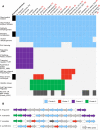Using comparative genomics to uncover new kinds of protein-based metabolic organelles in bacteria
- PMID: 23188745
- PMCID: PMC3588914
- DOI: 10.1002/pro.2196
Using comparative genomics to uncover new kinds of protein-based metabolic organelles in bacteria
Abstract
Bacterial microcompartment (MCP) organelles are cytosolic, polyhedral structures consisting of a thin protein shell and a series of encapsulated, sequentially acting enzymes. To date, different microcompartments carrying out three distinct types of metabolic processes have been characterized experimentally in various bacteria. In the present work, we use comparative genomics to explore the existence of yet uncharacterized microcompartments encapsulating a broader set of metabolic pathways. A clustering approach was used to group together enzymes that show a strong tendency to be encoded in chromosomal proximity to each other while also being near genes for microcompartment shell proteins. The results uncover new types of putative microcompartments, including one that appears to encapsulate B(12) -independent, glycyl radical-based degradation of 1,2-propanediol, and another potentially involved in amino alcohol metabolism in mycobacteria. Preliminary experiments show that an unusual shell protein encoded within the glycyl radical-based microcompartment binds an iron-sulfur cluster, hinting at complex mechanisms in this uncharacterized system. In addition, an examination of the computed microcompartment clusters suggests the existence of specific functional variations within certain types of MCPs, including the alpha carboxysome and the glycyl radical-based microcompartment. The findings lead to a deeper understanding of bacterial microcompartments and the pathways they sequester.
Copyright © 2013 The Protein Society.
Figures






References
-
- Gitai Z. The new bacterial cell biology: moving parts and subcellular architecture. Cell. 2005;120:577–586. - PubMed
-
- Jensen GJ, Briegel A. How electron cryotomography is opening a new window onto prokaryotic ultrastructure. Curr Opin Struct Biol. 2007;17:260–267. - PubMed
-
- Shively JM, Ball F, Brown DH, Saunders RE. Functional Organelles in Prokaryotes - Polyhedral Inclusions (Carboxysomes) of Thiobacillus Neapolitanus. Science. 1973;182:584–586. - PubMed
-
- Kerfeld CA, Heinhorst S, Cannon GC. Bacterial microcompartments. Annu Rev Microbiol. 2010;64:391–408. - PubMed
Publication types
MeSH terms
Substances
Grants and funding
LinkOut - more resources
Full Text Sources
Other Literature Sources
Miscellaneous

